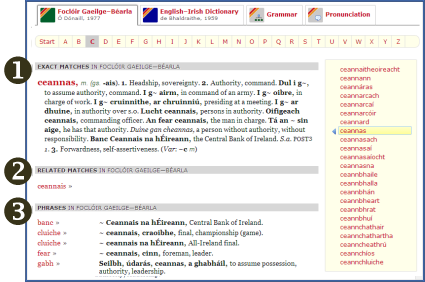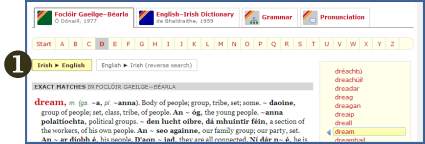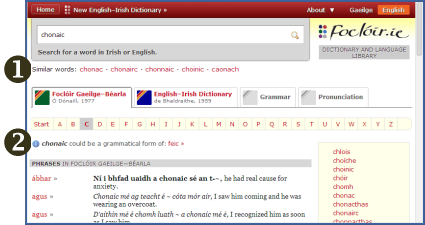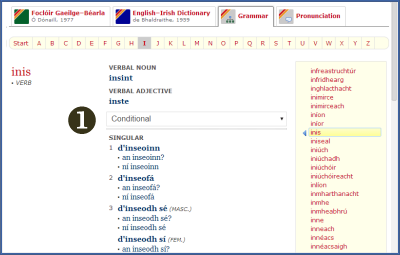How to use this website
This page explains how to use the website and its search functions effectively.

How to search
Type the word (or multi-word expression) you’re looking for into the search box at the top of the screen  . The word can be in Irish or English. Then press the Enter key on your keyboard or click the search icon in the search box.
. The word can be in Irish or English. Then press the Enter key on your keyboard or click the search icon in the search box.
As this website contains four separate collections, your search results will be presented under four tabs  . You can change between collections by clicking the tabs. A tab displayed in colour means that there are some results available in that collection. A greyed-out tab means there are no results in that collection.
. You can change between collections by clicking the tabs. A tab displayed in colour means that there are some results available in that collection. A greyed-out tab means there are no results in that collection.
If you started your search from the home page, the website will redirect you to whichever collection has the most relevant results. If you started your search from a particular collection, the search will be performed in that collection first.

How to understand the search results
If an entry is available that corresponds exactly to the text you searched for, you’ll get that entry at the top of your result list  . Underneath that you’ll find relevant parts of other entries that match your search
. Underneath that you’ll find relevant parts of other entries that match your search  .
.
You’ll also often be displayed a list of example sentences from other entries containing your search word (or words)  . This list gives you up to 50 sentences at first. If more are available, you’ll see a button at the bottom of the list which you can click to display more.
. This list gives you up to 50 sentences at first. If more are available, you’ll see a button at the bottom of the list which you can click to display more.

Search language
You can use this website to do a “reverse search” in the two dictionaries available here (Foclóir Gaeilge–Béarla and English–Irish Dictionary). When your search has yielded results in both languages, as it does in the case of ‘dream’ or ‘bean’ for example, you’ll see a row of buttons at the top  to switch between the language directions.
to switch between the language directions.

Spelling mistakes and other inaccuracies
The website automatically checks the spelling of every search and suggests similar words underneath the search box  . You may find this helpful if you do not know the correct spelling of the word you’re looking for.
. You may find this helpful if you do not know the correct spelling of the word you’re looking for.
Also, the search process is configured for inflection (in both languages) and mutation rules (in Irish). If you search for an inflected or mutated word, such as a verb in the past tense, the website will usually recognize that and offer the base form to you at the top of the result list  .
.
Multi-word search
If your search contains more than one word, it will yield a list of example sentences and other instances where all these words occur, even if they are not next to each other. For example, if you search ‘fear céile’ in English–Irish Dictionary, you’ll get several sentences where the two words co-occur, even when they are quite far from each other, such as ‘fear a ghlacadh mar chéile’.
The search algorithm applies the grammatical rules of both languages and automatically includes inflected and/or mutated forms. For example, if your search contains the English word ‘take’, it will return results that contain ‘took’, ‘taken’ and so on.
In Foclóir Gaeilge-Béarla, the system understands what most of the tildes (the symbols ~) stand for and uses this knowledge during the search. For example, if you search for lá fada, you’ll get several hits including those where one of the words is a tilde.

Further development on handling of tildes is planned in the future.

Reading the entries
In the case of Foclóir Gaeilge–Béarla and English–Irish Dictionary, the layout and formatting of entries is almost identical to how they appear in the printed dictionaries, with some additional colour-coding. Grammatical and other abbreviations appear in green and you can get an explanation of what they mean by hovering the cursor over them; the explanation will appear in a little pop-up box.

Using the grammar entries
Entries in the Grammar Database are presented as tables of inflected forms. These tables can be short or long depending on the part of speech. In the case of verbs, you can switch between different tenses and moods by making a selection from the drop-down list  .
.
Listening to sound files
In the Pronunciation Database you can listen to sound recordings by clicking on them. The sound should start playing almost immediately after a click. Make sure your speakers are on!

On mobile phones
This website is designed to be easy to use on small screens, such as on mobile phones. All you have to do is navigate with your web browser to the same address (teanglann.ie). The website will recognize that it is on a small screen and will reorganize itself into a more concise layout. Apart from that, the search functions are identical to those available on desktop computers.
